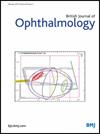Effect of daily disposable Defocus Incorporated Soft Contact lens on myopia control: a 1-year multicentre randomised controlled trial.
IF 3.7
2区 医学
Q1 OPHTHALMOLOGY
引用次数: 0
Abstract
AIM To investigate the effect of the Defocus Incorporated Soft Contact (DISC) lenses on myopia progression and choroidal thickness (ChT) of Chinese mainland children over a period of 12 months. METHODS This was a prospective double-blind randomised controlled trial involving 84 myopic children. Subjects were randomly assigned to use of either DISC or single vision contact lens (SVL). Cycloplegic spherical equivalent refraction (SER), axial length (AL) and ChT were measured at 6 and 12 months. RESULTS For 12 months, the average changes in SER and AL in the DISC group were (-0.50±0.41) D and (0.22±0.13) mm. Corresponding values in the SVL group were (-1.23±0.50) D and (0.49±0.15) mm. Myopia control efficacy in SER was 59% and 55% in AL. For those aged under 10, myopia control efficacy in SER is higher at 95% in 6 months and 71.4% in 12 months. ChT increased by 0.16±24.46 µm in the DISC group, while in contrast, it thinned in the SVL group (-9.11±32.25 µm) after 12 months. ChT changes demonstrated a significant negative association with AL over 12 months in the DISC group but not in the SVL group. In contrast, ChT change over 12 months was significantly negatively associated with initial ChT in the SVL group, but not in the DISC group. CONCLUSIONS DISC lenses effectively slowed myopia progression and AL compared with SVL, especially for younger children. Myopia defocus treatment changes the original intrinsic relationship between ChT and myopia progression, providing strong evidence that myopia defocus design controls myopia progression by changing ChT.每日一次性离焦软性隐形眼镜对近视控制的影响:一项为期一年的多中心随机对照试验。
目的探讨离焦软性接触镜(DISC)对中国大陆儿童近12个月近视进展和脉络膜厚度(ChT)的影响。方法84例近视儿童进行前瞻性双盲随机对照试验。受试者被随机分配使用DISC或单视力隐形眼镜(SVL)。在6个月和12个月时测量单眼瘫痪患者的等效球面折射(SER)、轴长(AL)和ChT。结果12个月内,SVL组SER和AL的平均变化分别为(-0.50±0.41)D和(0.22±0.13)mm, SVL组SER和AL的平均变化分别为(-1.23±0.50)D和(0.49±0.15)mm, SER和AL的近视控制效率分别为59%和55%,10岁以下儿童SER的近视控制效率分别为95%和71.4%。12个月后,DISC组ChT增加0.16±24.46µm, SVL组ChT减少(-9.11±32.25µm)。在12个月内,DISC组的ChT变化与AL呈显著负相关,而SVL组则没有。相比之下,SVL组12个月内的ChT变化与初始ChT呈显著负相关,而DISC组则没有。结论与SVL相比,disc镜片可有效减缓近视进展和AL,特别是对于低龄儿童。近视离焦治疗改变了原有的ChT与近视进展的内在关系,为近视离焦设计通过改变ChT控制近视进展提供了有力证据。
本文章由计算机程序翻译,如有差异,请以英文原文为准。
求助全文
约1分钟内获得全文
求助全文
来源期刊
CiteScore
10.30
自引率
2.40%
发文量
213
审稿时长
3-6 weeks
期刊介绍:
The British Journal of Ophthalmology (BJO) is an international peer-reviewed journal for ophthalmologists and visual science specialists. BJO publishes clinical investigations, clinical observations, and clinically relevant laboratory investigations related to ophthalmology. It also provides major reviews and also publishes manuscripts covering regional issues in a global context.

 求助内容:
求助内容: 应助结果提醒方式:
应助结果提醒方式:


